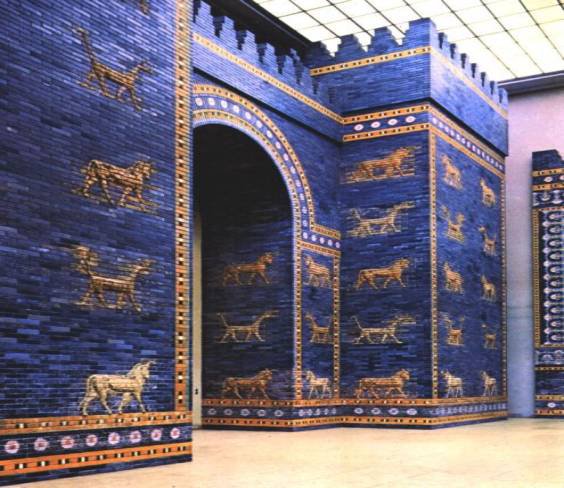بوابة عشتار: كانت البوابة الثامنة لمدينة بابل الداخلية، و قد تم إنشاؤها حوالي 575 ق.م. بأمر الملك نبوخذنصر الثامن في الجهة الشمالية من المدينة
و قد كرست للإلهة البابلية عشتار، و قد أنشئت من السيراميك الأزرق المزجج بالتبادل مع صفوف من تنين السيروث "مشخوششو" و حيوان الأرخص "ثور ضخم بقرون كبيرة"
السقف و الأبواب كانت مصنوعة من خشب الأرز حسب ما يذكر لوح التكريس، و من خلال البوابة يمر شارع الموكب المحدد بجدران مزينة بأسود على آجر مزجّج "حوالي 120 منها"
كانت تماثيل الآلهة تسيّر في مواكب خلال البوابة و في شارع الموكب كل عام خلال إحتفالات رأس السنة
البوابة و التي هي أصلا جزء من أسوار بابل كانت تعتبر أحد عجائب الدنيا حتى تم إستبدالها في القرن السادس الميلادي بمنارة الإسكندرية
لقد تمت إعادة تركيب بوابة عشتار و شارع الموكب في متحف البيرغامون في برلين بإستعمال مواد نقب عنها روبرت كولدوي، و قد تم العمل في ثلاثينيات القرن الماضي، و هي تضم لوح الكتابة. و هي ترتفع لحوالي 47 قدما أو 14 متر و بعرض 100 قدم أو 30 متر. إستمرت التنقيبات من عام 1902-1914 و خلال تلك الفترة تم تنقيب حوالي 45 قدما من أساسات البوابة
البوابة كانت في الحقيقة بوابة مزدوجة، و الجزء المعروض حاليا في متحف البيرغامون ما هو إلا الجزء الأمامي الأصغر، بينما أعتبر الجزء الخلفي الأكبر غير مناسبا لتقيده بتركيب المتحف، و هو محفوظ في المخازن
أجزاء من البوابة و أسود شارع الموكب موزعة في متاحف عدة حول العالم، فقط ثلاثة متاحف تمتلك التنانين بينما ذهبت الأسود لمتاحف عدة. متحف إسطنبول للآثار يمتلك أسود و تنانين و ثيران، بينما يضم متحف ديترويت للفن تنينا، متحف روسكا في غوتنبرغ في السويد يحوي أسدا و تنينا ، متحف اللوفر و متحف الدولة للفن المصري في ميونخ و متحف أونتاريو الملكي في تورنتو و متحف جامعة بنسلفانيا للآثار و الأنثروبولوجي في فيلادلفيا و متحف الميتروبوليتان للفن في نيويورك و المعهد الشرقي للفن في شيكاغو و متحف مدرسة رود أيلاند للتصميم و متحف الفنون الجميلة في بوسطن و معرض جامعة يال للفنون الجميلة في نيو هافن ، ولاية كونكتكت كل منها يملك أسدا
تم بناء مجسم أصغر للبوابة في العراق في عهد صدام حسين في مدخل المتحف الذي لم يتم إتمامه و قد لحق بهذا المجسم الضرر منذ الحرب الأخيرة
//////////////////////////////////////////////////////////////////////////////////////////
The Ishtar Gate (Assyrian: ܕܵܪܘܲܐܙܲܐ ܕܥܵܐܫܬܲܪ translit: Darwaza D'Ishtar, was the eighth gate to the inner city of Babylon. It
was constructed in about 575 BC by order of King Nebuchadnezzar II on the north side of the city.
Dedicated to the Babylonian goddess Ishtar, the Gate was constructed of blue glazed tiles with alternating rows of bas-relief sirrush (dragons) and aurochs.
The roof and doors of the gate were of cedar, according to the dedication plaque. Through the gate ran the Processional Way which was lined with walls covered in lions on glazed bricks (about 120 of them).
Statues of the deities were paraded through the gate and down the Processional Way each year during the New Year's celebration.
Originally the gate, being part of the Walls of Babylon, was considered one of the Seven Wonders of the world until, in the 6th century AD, it was replaced by the Lighthouse of Alexandria.
A reconstruction of the Ishtar Gate and Processional Way was built at the Pergamon Museum in Berlin out of material excavated by Robert Koldewey and finished in the 1930s. It includes the inscription plaque. It stands 47 feet high and 100 feet wide (14 meters by 30 meters). The excavation ran from 1902-1914 and during that time 45 feet of the foundation of the gate was uncovered.
The gate was in fact a double-gate. The part that is shown in the Pergamon Museum today is only the smaller frontal part, while the larger back part was considered too large to fit into the constraints of the structure of the museum. It is in storage.
Parts of the gate and lions from the Processional Way are in various other museums around the world. Only three museums acquired dragons while lions went to several museums. The Istanbul Archaeology Museum has lions, dragons, and bulls. The Detroit Institute of Arts houses a dragon. The Röhsska Museum in Gothenburg, Sweden, has one dragon and one lion; the Louvre, the State Museum of Egyptian Art in Munich, the Royal Ontario Museum in Toronto, the University of Pennsylvania Museum of Archaeology and Anthropology in Philadelphia, the Metropolitan Museum of Art in New York, the Oriental Institute in Chicago, the Rhode Island School of Design Museum, the Museum of Fine Arts in Boston, and the Yale University Art Gallery of New Haven, Connecticut, each have lions.
A smaller reproduction of the gate was built in Iraq under Saddam Hussein as the entrance to a museum that has not been completed. Damage to the reproduction gate has occurred since the Iraq war.
للمزيد الرجاء الأطلاع على // for more please visit
:: سلسلة أثريات ولوحات من بلادي ::







 رد مع اقتباس
رد مع اقتباس

